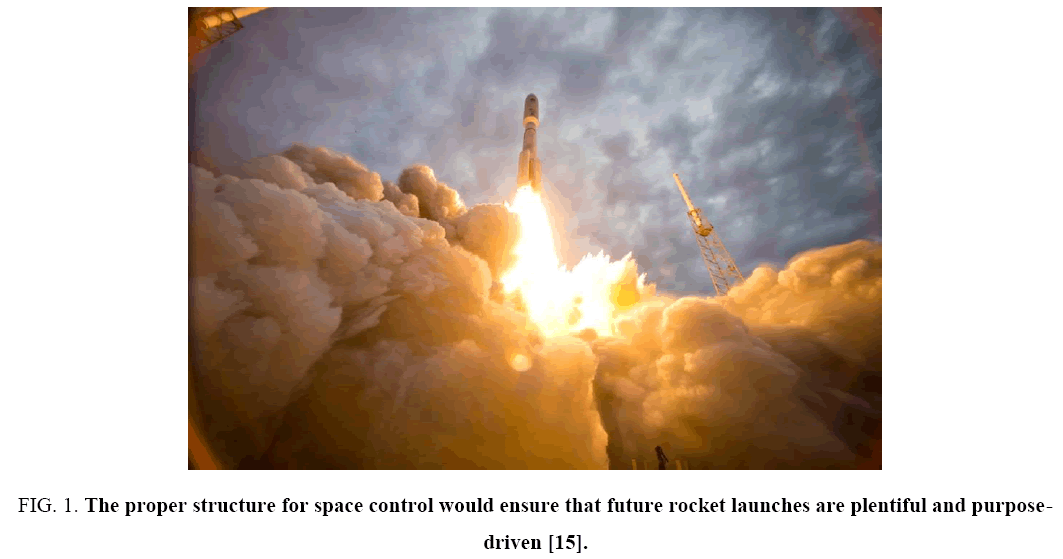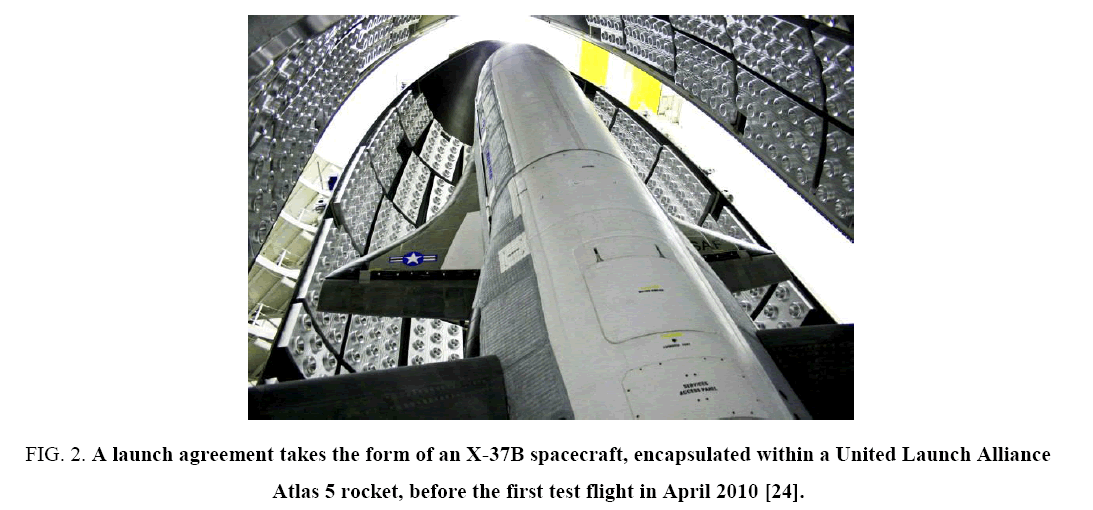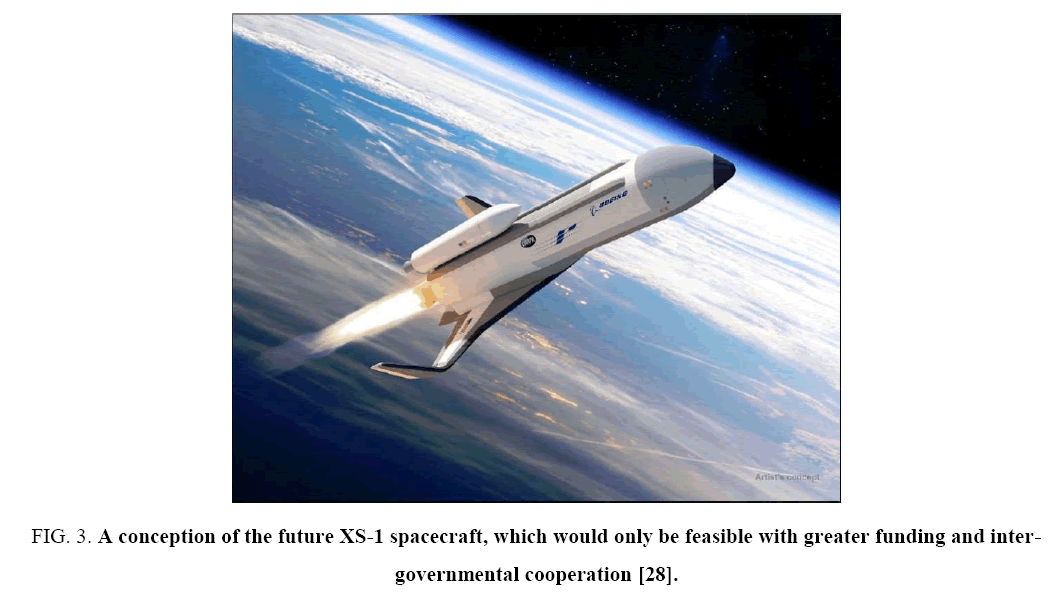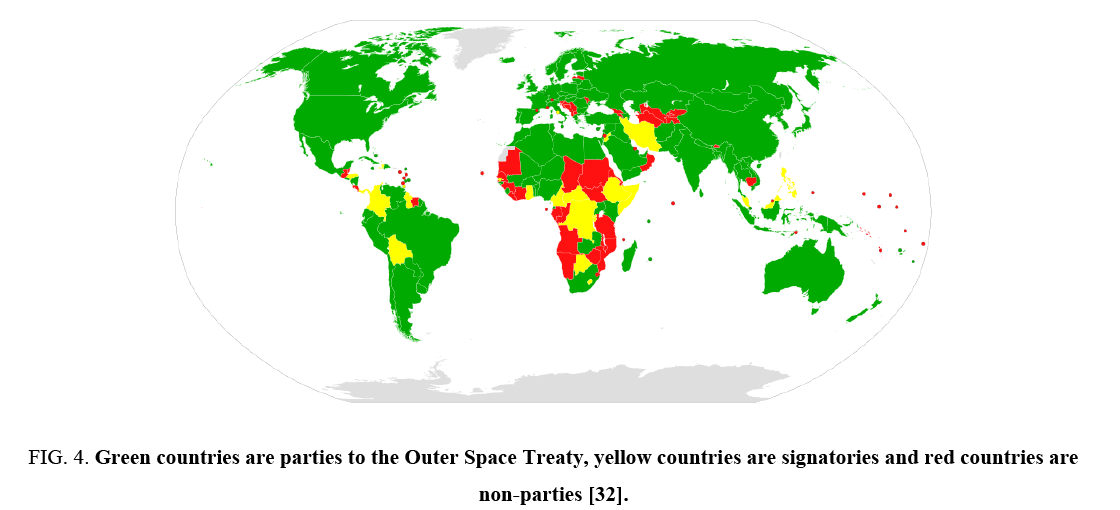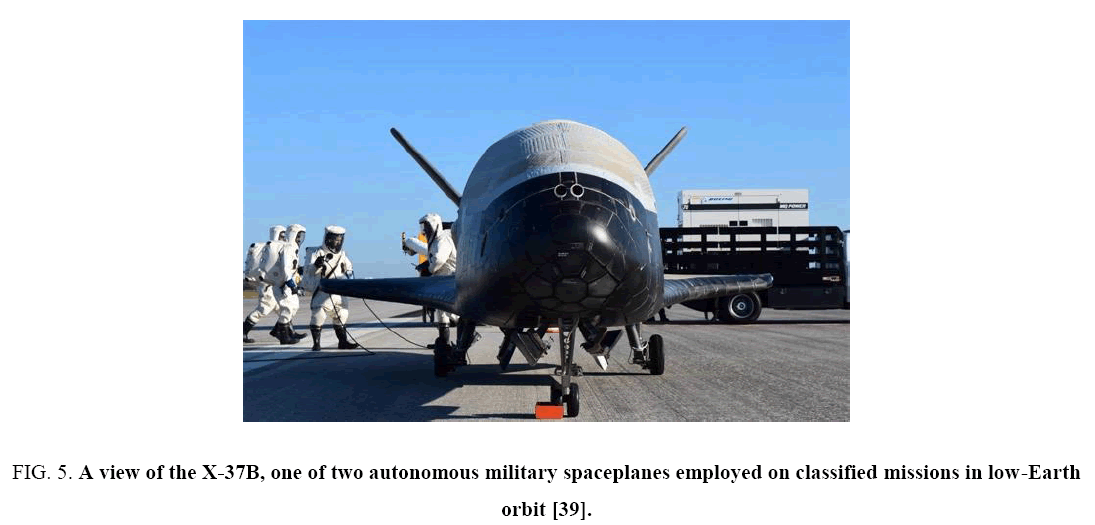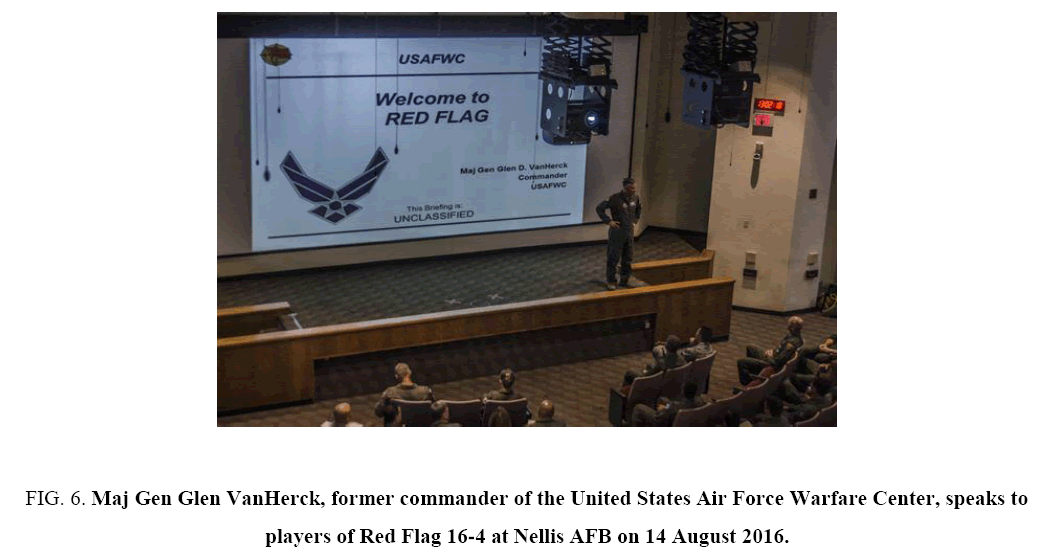Review
, Volume: 6( 3)Reshaping Space Corps: A Proposal for Maintaining American Space Superiority
- *Correspondence:
- Ormsbee M, United States Air Force, Washington D.C., USA, Tel: (917) 604-7279; E-mail: mhormsbee@gmail.com
Received: November 22, 2017; Accepted: December 11, 2017; Published: December 15, 2017
Citation: Ormsbee M. Reshaping Space Corps: A Proposal for Maintaining American Space Superiority. J Space Explor. 2017;6(3):136
Abstract
Currently, the most contentious idea for maintaining American space superiority is the proposal to create a Space Corps as a separate military branch. While various lawmakers on both sides of the aisle are in favor of the idea, many decision makers have criticized the idea. Yet, a renewed focus on American space control merits careful consideration and should not be dismissed because it focuses on a future conflict rather than a present problem. To revitalize space control, the Nation needs a different structure for the Space Corps by keeping the agency within the Air Force, but as a major command rather than a new military branch. In addition, the success of this proposal hinges on private sector partnerships, inter-governmental coordination, autonomous systems and intelligent training.
Keywords
Space; Military; Private sector; Autonomy; Law
Introduction
Currently, the most contentious idea for maintaining American space superiority is the proposal to create a Space Corps as a separate military branch [1-3]. The idea of a separate space agency within the Department of Defense (DoD) was discussed as long ago as the Space Race of the 1950s and again in 2000 by a commission led by former Defense Secretary Donald Rumsfeld, but it has been resurgent recently as the U.S. House of Representatives approved its 2018 defense authorization bill, which would form a separate Space Corps within the Air Force [4]. While various lawmakers on both sides of the aisle are in favor of the idea, many decision makers have criticized the idea [5]. The Secretary of the Air Force, Dr. Heather Wilson, said the U.S. should abstain from further complicating the Pentagon and funds should be used for “lethality and not bureaucracy. The White House called the proposal “premature”. Even in Congress, the proposal was dubbed a “solution in search of a problem [5].
Yet, a renewed focus on American space control merits careful consideration and should not be dismissed because it focuses on a future conflict rather than a present problem. The Air Force should take advantage of the current enthusiasm for space and seek to consolidate space operations and decision making in the Air Force itself rather than a new internal military branch or a sister service. In other words, refocusing and reinvesting in space defense is vital due to increasing international threats [6], but the current proposed structure of a Space Corps may unwittingly doom the new initiative.
To revitalize space control, the Nation needs a different structure for the Space Corps by keeping the agency within the Air Force, but as a major command (MAJCOM) rather than a new military branch. Next, the success of this proposal hinges on private sector partnerships, inter-governmental coordination, autonomous systems and intelligent training. The following proposals for deterrence and conflict resolution are consolidated in each section because, ultimately, they are virtually the same proposals; they differ primarily in timing, whether before or after a conflict.
Experimental
Structure
Establishing a Space Corps makes easy headlines and piques the interest of everyday Americans, but it signals a lack of thoughtfulness because it overlooks the preexisting military structure for controlling space and instead proposes extensive, disruptive reform. Rather than founding a new military service within the Air Force, the most effective and efficient measure to achieve the same goals is to revitalize the existing Air Force MAJCOM that already focuses on space operations: Space Command [7]. The Air Force Chief of Staff, General David Goldfein, has stated as much: “If you’re saying the word ‘separate’ and ‘space’ in the same sentence, you’re moving in the wrong direction. The secretary (of the Air Force) and I are focused on how we integrate space [8].”
Thus, any efforts to start a new military branch focused on space are duplicative and oblivious to the working structure and reforms already in place [9]. Removing space command and control to a separate branch would compound bureaucracy and wait times. Space Command, employing about 36, 000 people, is already a key MAJCOM within the most lethal air and space operation in existence. Moreover, there are reforms already in place to ensure that the Air Force does not fall behind adversaries. Just this year, the new three-star deputy chief of staff for space, known as the “A-11,” was publicized and will be the Air Force’s headquarters space advocate, helping to “integrate, normalize and elevate space” within the Air Force [10]. To establish a new military branch would take several years and the deadline set by the House of Representatives to form the Space Corps – by 1 January 2019 – is at best an extremely optimistic timeline. Finally, at the time of writing this essay, the U.S. Senate had not yet passed its version of the 2018 defense authorization bill, but by all indications, it is unlikely to pass a resolution that includes the Space Corps initiative, likely signaling that a separate military branch is not the wisest option to further American space power [11].
Still, the objections of many leaders may be to form rather than substance. With a more logical structure, the spirit of rejuvenated space defense may find broader support in both houses of Congress and the DoD. Investing in Space Command would at least leverage the strengths of the Air Force without the start-up costs and political tug-of-war inherent in forming a new military branch. After all, the Air Force has defended America for 70 years, accomplishing its overarching mission through its MAJCOMs, but a new Space Corps would represent an unknown quantity, which increases the risk of failure.
Ultimately, if Congress wishes to empower space defense, the DoD must first reexamine its intentions in space, then convey these intentions as a starting point for Space Command’s priorities. Currently, Space Command pursues numerous missions in space, including intelligence, surveillance and reconnaissance (ISR), global communications, navigation signals, meteorological information and scientific studies [11]. Space Command’s mission is so central that virtually every sector of military operations is affected by space operations [12]. To deter and overwhelm adversaries, the DoD must solidify a strategy that fulfills American interests in space as a support domain but also a battlefield [12]. According to Representative Mike Rogers (R-AL), chairman of the Armed Services Committee’s Strategic Forces Subcommittee, the U.S. must acknowledge that “warfighting” has become absolutely dependent on space [13].
Critics of the proposal that Space Command retain oversight for space operations rather than a new Space Corps will note that the Air Force itself was born as a separate service from the U.S. Army in 1947 and unquestionably, that new venture was a remarkable success. The Air Force evolved organically, however, over many years and through the conflicts of World War II, not by legislative fiat. Thus, branching off the Air Force was gradual and necessary, but a new space branch would be hurried and misguided. A competing proposal from the U.S. Senate proposes a new Chief Information Warfare Office to oversee “all matters relating to the information environment of the DoD,” including cyber, space, electronic warfare and the electromagnetic spectrum [14]. This proposal, however, is also not workable because it would remove an uncertain amount of control from the Air Force and dilute it in a new office with oversight over far too many domains (Figure 1).
Figure 1: The proper structure for space control would ensure that future rocket launches are plentiful and purpose-driven [15].
Moving forward, the DoD must craft a 20-year vision to signal our Nation’s seriousness of purpose and demonstrate our progress to near-peer competitors. This begins with a MAJCOM command structure that is unified and cohesive by taking over all or most of the DoD’s space mission. Thus, U.S. Army Space and Missile Defense Command, Naval Network and Space Operations Command, Space and Naval Warfare Systems Command and U.S. Marine Corps Forces Strategic Command will either refine their roles in support of the Air Force’s Space Command or they must shutter altogether. As it is, Space Command already shoulders most of the DoD’s space control operations. Yet, no DoD restructuring is fully empowered without cross-sector help to inject ingenuity and fast-tempo advances in a field that is dependent on technology.
Partnerships
Perfecting the architecture of Space Command is a start, but a government effort alone will not adequately deter adversaries in space. Instead, the DoD needs commercial partnerships because the era in which the U.S. military has the capability to internally develop era-defining technologies without the need for civilian collaboration is over [16]. There is simply no effective path forward without public-private partnerships (PPPs), which are negotiated joint ventures that meld the infrastructure and holdings of the U.S. Government with the innovative spark and nimble advances of private industry. This is true across most industries, but especially in spacecraft testing and development [17]. Jeff Bezos, the CEO of Amazon, bankrolls the steady progress of Blue Origin, his rocket company, with hopes of sending tourists and supplies into space [18]. SpaceX, Elon Musk’s rocket project, is now one of the world’s most valuable privately held companies, by some estimates worth about $21 billion [18]. While the U.S. Government very gradually increases space capabilities each year, it is the deep pockets and breakneck advances of private enterprise that regularly play across headlines.
One could lament the decline of the government’s grip on cutting-edge research and development (R&D), but one would thereby miss the golden opportunity to team with private firms in PPPs [19]. Such joint ventures augment the strengths of vast military resources with the ingenuity of private companies in ways that further government ends while allowing companies to profit in new markets [20,21]. Importantly, risk and reward are shared by the parties in creative and situation-specific ways that allow a party to address its weaknesses with the other party’s strengths (Table 1).
| Type of risk | Government | Private sector | Shared | Negotiable |
|---|---|---|---|---|
| Regulatory/Legislative |  |
|||
| Government default |  |
|||
| Planning and design |  |
|||
| Permits and approvals |  |
|||
| Construction |  |
|||
| Occupational/Workforce |  |
|||
| Operation/Maintenance |  |
|||
| Financial/Market |  |
|||
| Private sector default |  |
|||
| Political |  |
|||
| Acts of God |  |
Table 1: An example of a risk sharing distribution in a space sector PPP [21].
Launch agreements, which are akin to PPPs, are gaining popularity [22], but full PPPs are necessary to grow the military capacity for spacecraft development and deployments while helping private companies serve their shareholders (Figure 2). Indeed, studies indicate that the DoD is correct to continue to rely on commercial and civil partners to meet parts of its space mission [23].
Figure 2: A launch agreement takes the form of an X-37B spacecraft, encapsulated within a United Launch Alliance Atlas 5 rocket, before the first test flight in April 2010 [24].
Any measure of deterrence or demonstration of space power must stem from a robust ecosystem that synthesizes military objectives with private industry R&D. Space sector partnerships would threaten adversaries while allowing the U.S. Government to serve the public by employing a cost-effective joint venture with private firms. Space operations constitute the “nerve center” of military and civilian communications and planning, so to give this proposal anything less than a full military and commercial effort would do a disservice to the Nation. Even with PPPs, however, Space Command cannot reach its full potential without harmonization within the U.S. Government.
Inter-Governmental coordination
If looking beyond DoD capabilities to partnerships in the private sector gives teeth to Space Command, then broadening the scope even further to include full legislative and executive governmental coordination gives the new initiative fangs. The DoD and Air Force must develop a multi-faceted effort that draws in political and diplomatic actors in conjunction with military and industrial leadership.
Congress can show its support by appropriating increased funds to space defense in its annual defense authorization bill. This is perhaps the most unequivocal method of communicating to the DoD where congressional (and thus the public’s) priorities lie. Of course, this necessitates either an overall increase in the defense budget, which will undoubtedly face political opposition or a re-allotment of funds from other defense expenditures [25].
With a diplomatic thrust to counter Chinese and Russian space advances, however, an increase in the defense budget to fund reinforced space defense may be realistic [25]. The current House bill proposal lays out several purposes for a new space initiative, authorizing deterrent and warfighting measures [26]. With the threat of foreign advances reminiscent of the Cold War, public favor for Space Command will likely follow, leading legislators and the White House to respond with increased funding.
The Air Force can also do more to allay lawmakers’ fears that it cannot balance its competing missions. Congress members have expressed skepticism that the Air Force stands fully behind Space Command’s mission if such mission were to compete head-on with F-35s, for example [27]. But with greater funding and public support, Space Command will be empowered to pursue its mission independent of the demands of air operations. Also, as a separate MAJCOM within the Air Force, Space Command is well situated to leverage congressional and public support to send a message of preparedness and robust operations to would-be aggressors (Figure 3).
Figure 3: A conception of the future XS-1 spacecraft, which would only be feasible with greater funding and inter-governmental cooperation [28].
Finally, Space Command requires the freedom to make unhindered decisions in our Nation’s best interests should deterrent measures go unheeded. This begins by loosening the legal and diplomatic constraints placed on the U.S. fifty years ago in the Outer Space Treaty. Signed in 1967, this treaty prevents the U.S. from taking certain aggressive measures or introducing specific weapons in space [29]. Without question, this treaty is outdated and unduly restrictive, placing limits on weapons in space and requiring signatory nations to provide “authorization and continuing supervision” of space activities by non-governmental entities, including companies, under their national jurisdiction [30,31]. Despite a longstanding adherence to the treaty (along with certain other countries, as depicted in Figure 2), the U.S. must give notice at its earliest opportunity that it shall withdraw from the strictures of the treaty, unless agreeable amendments are passed (Figure 4).
Figure 4: Green countries are parties to the Outer Space Treaty, yellow countries are signatories and red countries are non-parties [32].
Withdrawing from the Outer Space Treaty or at least amending the treaty regime, will free Space Command to weigh all necessary options to win in the “ultimate high ground [33]. This is not to imply that our Nation would thereafter employ weapons of mass destruction in space, but without removing the current constraints of the Outer Space Treaty, our Nation may find itself a sitting duck if a near-peer country should take an unexpectedly aggressive posture in the future. Seeking a more favorable treaty environment will not by itself guarantee victory, but failing to do so may ensure that we are not adequately positioned for victory. Importantly, amending the treaty or withdrawing from it will allow the U.S. to employ measures, such as autonomous systems, that could embody America’s salvation in a crisis.
Autonomous systems
The DoD, private partners and congressional and executive appointees must embrace the newest addition to air and space operations: autonomous systems. While automation allows a computer system to function with little or no human involvement (but with limited and specific actions) [34], autonomy generally “involves the use of additional sensors and more complex algorithms to provide higher levels of automated behaviors over a broader range of operating conditions and environmental factors” [35]. The DoD already employs autonomous systems in certain defense capabilities, such as the Tomahawk cruise missile, which can pilot itself autonomously and the X-37B space plane [36]. Yet, space operations are ripe for even greater use of autonomous systems, which could guide satellites, calculate trajectories and orbits and interface with humans in complex tasks.
To maintain its edge over rivals, Space Command must offload more tasks to autonomous systems to free up Airmen for higher-level strategy. Autonomous systems will not overtake or replace human Airmen; rather, they will serve our mission by augmenting Airmen’s capabilities while compensating for innate human shortcomings [37]. Synchronizing human and machine capabilities has been called “centaur warfighting,” named after the half-man, half-horse being from Greek mythology [38]. Centaur warfighting lends itself as the next era in computer-assisted human conflict resolution.
Advantages over adversaries can be measured in discrete technological breakthroughs. While autonomous spaceplanes are already in place, the potential for even greater autonomous systems in satellite control and information processing represents one of the key competitive advantages the U.S. holds over Russia or China. Yet, even as autonomous systems complete the infrastructure of a revitalized Space Command, prevailing in space will still hinge on effective training for Airmen and civilian counterparts (Figure 5).
Figure 5: A view of the X-37B, one of two autonomous military spaceplanes employed on classified missions in low-Earth orbit [39].
Results and Discussion
Training
Finally, it is not enough to have the right decision makers and tools for Space Command. In addition, the Air Force requires an intelligent approach to training for space control. Exercises like Red Flag at Nellis Air Force Base have already intelligently shaped conflict response and counter-response for air operations, but such exercises can translate for space conflicts as well [40]. In particular, Airmen must prepare today for realistic, aggressor-specific attacks in space and earth-bound space operations. This entails cooperation with the U.S. intelligence community to shed light on the space capabilities and potential methods of attack by Russia, China and other ambitious nations. In April of this year, the Air Force held a space version of the famed Red Flag wargames called “Space Flag,” allowing “space operators mission planning experience and opportunities to apply tactics, techniques and procedures in response to a thinking adversary” [41]. Training exhaustively for specific threats with new simulations promises that Space Command can react quickly and appropriately when a real threat occurs.
In addition, training must involve trusted private sector partners in PPPs, so that if a comprehensive industrial-military effort is required in a conflict, our forces can produce adequate counter-space measures in response to a realistic threat. If this means greater demands and coordination with private partners, then private shareholders should be pleased by rising stock prices as result. In any case, private partners must work closely with Space Command to monitor how PPP-driven products perform and to tweak them in real time (Figure 6).
Figure 6: Maj Gen Glen VanHerck, former commander of the United States Air Force Warfare Center, speaks to players of Red Flag 16?4 at Nellis AFB on 14 August 2016.
Space Command must abide by the maxim, “We must train as we fight because we fight as we train.” For this reason, training must address each of three space subcategories: Space situational awareness, defensive counter-space and offensive counter-space. Space situational awareness includes ISR, intelligence and analysis activities. Defensive counter-space includes space capabilities meant to thwart enemy attacks or interference. Finally, offensive counter-space would focus on interfering with aggressors’ use of space to their advantage [42,43]. Each of these subcategories is vital to space control and each should overlap seamlessly in much the same way that they do in real operations.
Conclusion
Deterring aggression and prevailing against adversaries in space presents a challenge because despite the importance of space control, real, live space disputes warranting serious military involvement are not yet commonplace. Lawmakers have warned, however, against a possible “Space Pearl Harbor,” in which American forces are fully unprepared for a sudden and massive attack. Still, for some, it makes sense to plan only for situations presently confronting our Nation because future attacks are purely hypothetical.
General Bernard A. Schriever would disagree with the wait-and-see approach. In 1957, he said, “In the long haul, our safety as a nation may depend on our achieving space superiority. We should be spending a certain fraction of our national resources to ensure that we do not lag”. Soon after this statement, the Soviet Union launched the first satellite into space and put the first man in space. Keeping General Schriever’s prophetic words in mind, legislators and commanders must rethink overall operations by placing space in a higher visibility position within the multi-domain spectrum to ensure that America does not fall behind again.
The spirit of the current Space Corps proposal is spot on. Knowing that humans will ultimately wage conflict in every realm we occupy, it is certain that space embodies yet another forum for nation state rivalry. Our Nation needs a stronger proposal; however, that maximizes Air Force structure, partnerships and training. In this way, the Air Force can maintain the American advantage in space for peaceful purposes, but also for the possibility of conflict.
Disclaimer
The views and opinions expressed or implied herein are those of the author alone and should not be construed as carrying the official sanction of the Department of Defense, Air Force or other governmental agencies.
References
- Report of theCommission to Assess United States National Security, Space Management and Organization. 2001.
- Cochrane E.Forces Align Against a New Military Branch to ‘Win Wars’ in Space.New York Times.2017.
- Herb J.House Passes Defense Bill that Would Create Space Corps.CNN. 2017.
- Hellman G.Trump Administration Targets Space Corps.Politico. 2017.
- Fernandez A.Military Role in Space Control: A Primer.Congressional Research Service. 2004.
- http://www.afspc.af.mil/About-Us/Heritage
- Friedberg SJ.Space Corps, what is it good for?Not much: Air force leaders. Breaking Defense. 2017.
- Rogers M.Let the U.S. Air Force Mature into the Space Force.Defense One. 2017.
- AF Announces Major Changes to Space Enterprise.Secretary of the Air Force Public Affairs. 2017.
- Gould J.Senators Sending Lofty Space Corps Hope Down to Earth.Navy Times. 2017.
- Berman R.Does the U.S. Military Need a Space Corps?The Atlantic. 2017.
- Kheel R.Government Debates Need for Military Space Corps. The Hill. 2017.
- Houck C.US Lawmakers Call for Space Force, Boost to Military Drills in Europe.Defense One. 2017.
- Photo courtesy of U.S. Air Force.
- Davenport C. Why the Pentagon is Wooing Silicon Valley (and the Valley is playing hard to get).Washington Post. 2015.
- Broad WJ.Billionaires with Big Ideas Are Privatizing American Science.New York Times. 2014.
- Benner K, Chang K. SpaceX is Now One of the World’s Most Valuable Privately Held Companies.New York Times. 2017.
- Perhaps more importantly, in accordance with U.S. DoD Directive 5000.01.
- Chang IY, Galing S, Wong C, et al.Use of Public-Private Partnerships to Meet Future Army Needs, MR-997-A.Rand Arroyo Center. 1999.
- Sabol P, Puentes R.Private capital, public good: Drivers of successful infrastructure public-private partnerships.The Brookings Institution. 2014.
- Clark S.U.S. Air Force Taps SpaceX to Launch Next X-37B Spaceplane Mission.Spaceflight Now.
- Douglas M, Gray A.The Warfighters’ Counter-space Threat Analysis (WCTA): A Framework for Evaluating Counter-space Threats.Naval Postgraduate School. 2000.
- Photo courtesy of U.S. Air Force.
- This is despite a recent request to boost the space budget by 20 percent, though the starting budget amount is too little.Ibid., supra note 15 (“This year’s budget request asks to boost space funding by 20 percent, a not insignificant amount of money.”).
- According to the U.S. House of Representatives version of the 2018 defense authorization bill, duties of the new space initiative would include “protecting the interests of the United States in space; deterring aggression in, from and through space; providing combat-ready space forces that enable the commanders of the combatant commands to fight and win wars; organizing, training and equipping space forces; and conducting space operations of the Space Corps under the command of the Commander of the United States Space Command.”
- Freedberg SJ.Rogers ‘Pissed’ at Air Force Opposition to Space Corps.Breaking Defense. 2017.
- Illustration credit Defense Advanced Research Projects Agency.
- http://www.unoosa.org/oosa/en/ourwork/spacelaw/treaties/introouterspacetreaty.html
- https://www.state.gov/t/isn/5181.htm
- Foust J.Is It Time to Update the Outer Space Treaty?The Space Review. 2017.
- Photo courtesy of Wikipedia.
- Testimony of U.S. Secretary of Defense Donald H. Rumsfeld prepared for the House Armed Services Committee hearing on 2003 Defense Budget Request. 2002.
- The Role of Autonomy in DoD Systems.Defense Science Board, Department of Defense. 2012.
- Krogmann U. From Automation to Autonomy: Trends towards Autonomous Combat Systems.Advances in Vehicle Systems Concepts and Integration (RTO MP-44); see also Schooley, L.C., et al.High Autonomy Control of Space Resource Processing Plants.IEEE Control Systems. 1993:29-39.
- Pietrucha M.Why the Next Fighter Will be Manned and the One After That.War on the Rocks. 2015.
- Autonomous Horizons: System Autonomy in the Air Force-A Path to the Future, Volume I: Human-Autonomy Teaming.U.S. Air Force Office of the Chief Scientist. 2015.
- Rosenberg M, Markoff J.The Pentagon’s ‘Terminator Conundrum’: Robots that Could Kill on Their Own.New York Times. 2016.
- Harwood W.Air Force Space Plane Lands after Secret Mission.CBS News. 2017.
- http://www.nellis.af.mil/About/Fact-Sheets/Display/Article/284176/414th-combat-training-squadron-red-flag
- Swarts P. Air Force Launches ‘Space Flag’ Exercise Inspired by Imax-worthy Red Flag War Games.Space News. 2017.
- Miller F.Red Flag 16-4: Challenge Issued, Challenge Accepted.20th Fighter Wing Public Affairs. 2016.
- Stout D.Gen. Bernard Schriever, 94, Air Force Missile Chief, Dies.New York Times. 2005.
